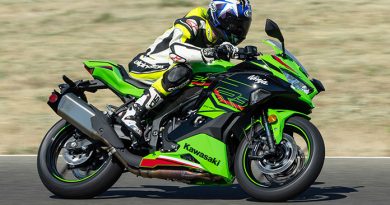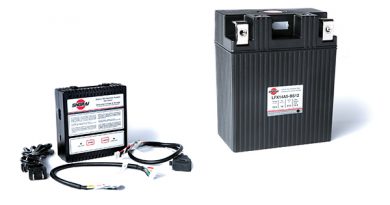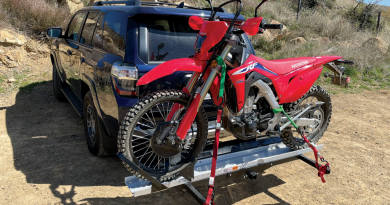How to Survive a Motorcycle Speed Wobble or Better Yet, Avoid One Altogether
Speed wobbles, tank slappers, head-shakers, call them what you will. The bottom line is, they’re scary as hell. But what are they, and how do they happen? What’s more, how can you take control and live to tell the tale?
What is a Speed Wobble?
Simply put, a speed wobble occurs when your motorcycle handlebars start to oscillate or, to put it in scientific terms, waggle back and forth.
Lateral movement in the handlebars may be the first sign that all is not well. But they are merely translating the weaving movement of the front wheel.
There is an entire list of reasons why this phenomenon occurs. We’ll cover this later, but if left, one of three things will often happen.
First off, a speed wobble may correct itself, which means the drama ends as quickly as it appeared. Secondly, you apply counter maneuvers and bring your motorcycle under control.
Lastly, the movement becomes more exaggerated and deteriorates into a tank slapper.
As the name suggests, a tank slapper is when the handlebars waggle back and forth. The movement however, is so violent that they go from lock to lock or hit each side of the petrol tank.
This great vintage Dunlop safety video shows how speed wobbles were dealt with back in the 1970s.
At this stage, unless you’ve got a backpack full of four-leaf clovers, you could be about to hit the tarmac.
If you’ve never experienced a speed wobble before, that’s great. And let’s hope you never do, but here is something you should know.
Most motorcycles on the road today will have a slow speed wobble if you take your hands off the handlebars. And that is 100 percent expected.
How do Speed Wobbles Happen?
Slow-speed wobbles occur due to your bike’s geometry. Imagine the angle of the front forks is extended to reach the floor. You’ll notice that it’s a way in front of the tire’s contact area with the road. This distance between the two points is known as the trail.
As a result, at slow speeds (before enough momentum builds up), the supermarket trolley effect kicks in, causing the wheel to shimmy. As mentioned above, this will occur on almost every street bike, tourer, or cruiser. It’s only noticeable if you remove your hands from the bars.
Example 1:
The moment the bike crosses the centerline, the rider is in trouble. Why? Because the uneven line momentarily takes the front and back wheel out of alignment. The excess speed has done the rest. The rider stays upright because he remains calm, rolls off the throttle, using engine braking to get to a low enough speed for the steering to compensate for the wobble.
Sports bikes are somewhat different because the rake angle is a lot tighter, meaning the trail is shorter.
But don’t think for one moment that because of their shorter trails, sports bikes have a get-out-of-jail-free card. The majority of YouTube videos featuring speed wobbles are shot through sports bike’s Clip-On handlebars. And we’ll explore this further in a moment.
A motorcycle will go into a speed wobble for many different reasons, these include:
- Poor tire inflation
- Worn tires
- Wrongly fitted tires
- Chain adjusted incorrectly
- Worn rear suspension, front forks, or steering head bearings
- Worn swinging arm bushes or rubber engine mounts
- A disproportionate amount of fork oil in each leg
- Large luggage boxes
- Large panniers
- Poorly packed or too much luggage
- Heavy acceleration
- Heavy landing after a wheelie
- Construction grooves or tar snakes on the road
- Hitting an object on the road
- Riding over raised lane markers at speed
While not an exhaustive list, these are the most frequent reasons and all have two things in common; weight distribution and traction. It is this shift in weight distribution or the wheels going out of alignment that starts a front wheel flutter or wobble.
Except for one item on our list, all of the speed wobbles result from inadequate maintenance, poor packing, or sheer bad luck. The aforementioned exception is of course, wheelies.
Pull the front wheel up and land heavily, and it’s going to result in a tank slapper. You may be lucky and live to tell the tale. On the flip side, you may lose control and end up stuck in the tread of a 16-wheeler.
The reason for the wheelie-related speed wobble is because, when the front end lifts, without you realizing it, the handlebars will turn slightly. If the wheel isn’t pointing dead straight ahead when you land, your motorcycle’s steering geometry attempts to correct the problem, which results in a shimmy in the wheel.
How to Walk Away or Prevent a Speed Wobble
As scary as speed wobbles are, there are things you can do to navigate through them or, better still, prevent them from happening altogether.
Example 2
If you need proof that a motorcycle knows more than its rider, check out this video. At 0.37, the bike goes into a violent tank slapper, which could have something to do with crossing over the lane marker at 283kph! The rider takes his hands off the bars altogether, but the engine braking slows the bike down to a speed that the steering geometry can cope with.
Prevention is better than cure, so let’s start there. At least six items on our list all relate to maintenance or the lack of it. Whatever type of motorcycle you ride, whether you do your own spanner work or take it to a shop, remember, you are ultimately responsible for your bike.
Before every ride, give your bike the once over. This process takes a couple of minutes, and you can check your motorcycle out as you put on your lid and gloves.
The procedure involves giving the tires a kick or a prod and lifting the drive chain with your boot. Next, run a finger around or visually inspect the forks. Finally, bounce up and down on the suspension and pump the brakes.
Spending even a short amount of time giving your motorcycle a pre-ride check can produce valuable information. It can tell you if your forks are leaking if your tires are underinflated, if your chain is tensioned correctly, and if your rear suspension is too soft.
A loose drive chain won’t cause your handlebars to thrash around, but a rear-wheel misaligned during a routine service will.
Luggage
For a road trip, you may be cramming everything plus the kitchen sink into panniers and a rear rack. Alternatively, you may have a humongous rear box for commuting. Either way, overload your motorcycle with luggage, and you’re heading for the land of wobble.
You may have too much weight placed too far back, or you’ve upset the aerodynamics by stacking too high. To fix this, you can redistribute the weight with a great choice of backpack. If that’s not possible, keep below the speed that the wobble sets in.
20 Motorcycle Records of All Time: On A Wing and a Prayer
General Wobbles
A motorcycle knows a lot more of how to get out of a speed wobble than its rider. An oscillating front wheel is not how it wants to operate, so it will be doing its best to solve the problem.
You will not be helping matters if you apply a sudden death grip on the handlebars and start to wrestle with them. While this is a normal reaction, the optimum way of dealing with a speed wobble is to roll the throttle off smoothly. Lean forward slightly, hold onto the handlebars but maintain a neutral grip.
The neutral grip is essential and can’t be overemphasized. While your instinct is to hang on, you’re hindering the recovery process in wrestling with the bars.
Do not grab the front brake. It will only make things worse. If you can’t wait for engine braking to slow you down, use only small amounts of the back brake. The speed wobble should go as soon as you take evasive action and begin slowing down.
Do:
- Remain calm
- Roll the throttle off smoothly
- Lean forward slightly and grip the tank with your knees
- Let the engine braking slow you down
- Use the back brake only if needed
- Keep a neutral grip on the handlebars
Don’t:
- Panic
- Try and accelerate out of the wobble, unless you’re a Moto GP or Stunt rider
- Suddenly sit bolt upright or lean back, especially if you’re traveling at speed
- Grab a handful of the front brake
- Put the handlebars in a death grip and wrestle the bike
- If you haven’t got the skill to bring the front end down under control after a wheelie, don’t do them!
The most important thing to remember about speed wobbles is that unless you do something dumb, you will walk away unscathed. And the only casualty will be your underwear!
Don’t be too hard on yourself either. No-one is born a great motorcycle rider; it takes patience, hard work, and many miles under your wheels. If at all possible, take an advanced riding course or even an off-road riding course. A track day or track-based racing school would also be of great help.
Without the knowledge to deal with or prevent a speed wobble, the most dangerous part of a tank slapper could be you. How to Survive a Speed Wobble or, Better Yet, Avoid One Altogether gives you the best chance of living to tell the tale.
Oh, and by the way – a good old speed wobble can also happen for even the best riders in the world:
The post How to Survive a Motorcycle Speed Wobble or Better Yet, Avoid One Altogether appeared first on Old News Club.



